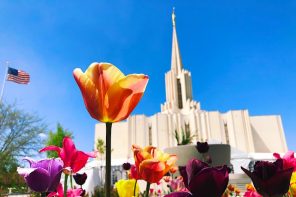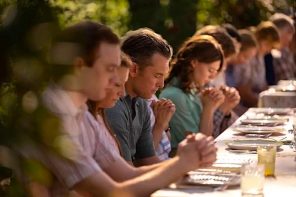Congratulations, readers. We’ve all survived the Mormon moment. Let’s take stock of seven top stories on Mormonism before we kiss 2012 goodbye:
1. Mitt Romney becomes first Mormon to secure major party nomination for U.S. President. As in 2008, the Romney campaign carefully avoided discussion of religion—excepting a few hand-picked character testimonials at the August GOP Convention—and campaign-season mainstream media coverage of the faith was neutral to positive. Still, Romney’s reticence to present his Mormonism-steeped human side may have allowed the Obama campaign to define him as a wealthy mogul detached from the everyday worries of everyday Americans. After a post-debate early October surge, Romney loses the November election, 53%–47%. (For RD’s take on how Romney might have addressed religion, see here and here.)
2. LDS Church lowers the minimum age for missionary service for women from 21 to 19. The policy change, announced in October, was hailed as a welcome step towards leveling life expectations and opportunities for religious study and service among young Mormon men and women. And it resulted in a dramatic spike of new missionary applications from young Mormon women. (More here.)
3. Mormon athletes prove more popular than Mormon presidential candidate. That’s a hunch, not a scientific observation: we’re still waiting for the Pew Forum numbers on this one. But can you really talk Mormons in 2012 without saying the names Jimmer Fredette, Manti Te’o, and Jabari Parker? Te’o, a linebacker from Laie, Hawaii, finished his senior season at Notre Dame as the most decorated defensive player in collegiate football history. Shooting guard Fredette finished his senior season at Brigham Young University as the leading scorer in all of Division 1 NCAA basketball; never mind the NBA. And Chicago-native Parker, a high school senior and power forward, made the cover of Sports Illustrated, then announced his intention to play for Duke in 2013–2014. Here at RD, we were too absorbed in the week-by-week of the long election season to cover Fredette, Te’o, and Parker—a pity, really.
4. Mormon feminists and allies organize worldwide “Pants to Church” Sunday to raise awareness and start dialogue about women’s issues in the LDS Church. With thousands of women and men (wearing purple in solidarity) participating worldwide, the event is the largest concerted feminist effort in Mormon history. Although internet reaction to the event is fierce—including threats of violence and ecclesiastical action against pants-wearing women—the day passes peacefully, earning national media notice and sparking new conversation among Mormons about gender, feminism, and faith. (More here and here.)
5. Mormons march in LGBT pride parades in a dozen cities. Hundreds of self-described “faithful” and “active” Mormons marched behind the banners of the grassroots “Mormons Building Bridges” and “Mormons for Marriage Equality” groups, with the largest contingent of 300–400 taking part in May’s Salt Lake City LGBT Pride Parade. (RD covered the movement here and here and here and here.)
6. Election-year media scrutiny discloses lingering LDS racism, prompting official statement from the LDS Church. Racist comments defending the LDS Church’s century-long ban on black priesthood ordination by BYU religion professor Randy Bott appear in the Washington Post, prompting embarrassment among rank-and-file LDS people and a statement from LDS Church headquarters acknowledging past racism and suggesting that there are no doctrinal grounds for believing the ban to have been divinely intended. (More here and here.)
7. Evangelical Christians more or less get behind Romney, setting aside longstanding antipathy towards Mormons. Never mind the random anti-Mormon postcard mailings from roadside ministries in Florida. The big names in evangelical Christianity pretty much agreed as of September 2012 to support Mitt Romney. Even Billy Graham scrubbed an anti-Mormon “cult” reference from his website. And the rank-and-file pretty much followed, turning out in greater proportions for Romney than they did for McCain in 2008. Was anyone really surprised? (More here and here.)




